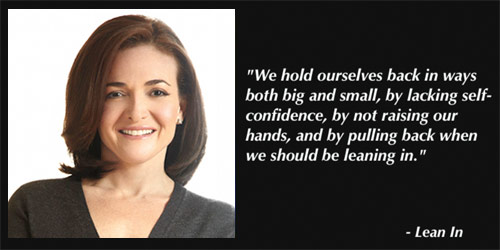 ‘Lean In: Women, Work, and the Will to Lead’
‘Lean In: Women, Work, and the Will to Lead’
By Sheryl Sandberg, COO of Facebook
Sheryl Sandberg Chief Operating Officer of Facebook, recently released her new book ‘Lean In: Women, Work, and the Will to Lead’ – it has received tremendous attention.
In the book Sandberg recounts her own experiences and dilemmas with very honestly, making it easy for women across cultures and geographies to identify with her. An interesting and worthwhile read with a powerful and motivating message. We recommend it.
Find it on Amazon
Description:
Thirty years after women became 50 percent of the college graduates in the United States, men still hold the vast majority of leadership positions in government and industry. This means that women’s voices are still not heard equally in the decisions that most affect our lives. In Lean In, Sheryl Sandberg examines why women’s progress in achieving leadership roles has stalled, explains the root causes, and offers compelling, commonsense solutions that can empower women to achieve their full potential.
Sandberg is the chief operating officer of Facebook and is ranked on Fortune’s list of the 50 Most Powerful Women in Business and as one of Time’s 100 Most Influential People in the World. In 2010, she gave an electrifying TEDTalk in which she described how women unintentionally hold themselves back in their careers. Her talk, which became a phenomenon and has been viewed more than two million times, encouraged women to “sit at the table,” seek challenges, take risks, and pursue their goals with gusto.
In Lean In, Sandberg digs deeper into these issues, combining personal anecdotes, hard data, and compelling research to cut through the layers of ambiguity and bias surrounding the lives and choices of working women. She recounts her own decisions, mistakes, and daily struggles to make the right choices for herself, her career, and her family. She provides practical advice on negotiation techniques, mentorship, and building a satisfying career, urging women to set boundaries and to abandon the myth of “having it all.” She describes specific steps women can take to combine professional achievement with personal fulfillment and demonstrates how men can benefit by supporting women in the workplace and at home.
Written with both humor and wisdom, Sandberg’s book is an inspiring call to action and a blueprint for individual growth. Lean In is destined to change the conversation from what women can’t do to what they can.


 Remember to practice safety at all times – at work, at home, at school, when you are driving.
Remember to practice safety at all times – at work, at home, at school, when you are driving. The National Safety Council acknowledges that the results announced today by the AAA Foundation for Traffic Safety of a new distracted driving study, again confirm the presence and crash risk of cognitive distraction. The human brain is incapable of performing, at the same time, the tasks necessary to safely operate a motor vehicle while engaged in other cognitively demanding tasks such as a phone conversation or speech to text.
The National Safety Council acknowledges that the results announced today by the AAA Foundation for Traffic Safety of a new distracted driving study, again confirm the presence and crash risk of cognitive distraction. The human brain is incapable of performing, at the same time, the tasks necessary to safely operate a motor vehicle while engaged in other cognitively demanding tasks such as a phone conversation or speech to text.